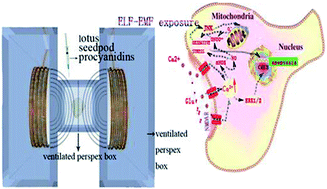Extremely low frequency electromagnetic field exposure causes cognitive impairment associated with alteration of the glutamate level, MAPK pathway activation and decreased CREB phosphorylation in mice hippocampus: reversal by procyanidins extracted from the lotus seedpod
Abstract
Lotus seedpod procyanidins (LSPCs) could effectively prevent learning and memory damage and oxidative damage caused by extremely low frequency electromagnetic field (ELF-EMF) exposure. However, LSPCs protect neurons from ELF-EMF-induced damage by mechanisms currently not clear. An excessive release of glutamate is considered to be one of the molecular mechanisms of neuronal damage in several neurological diseases. In this study we determined whether the ELF-EMF (50 Hz, 8 mT, 28 days) exposure induced alterations of glutamate release in mice hippocampus and explored the possible mechanism, and if LSPC treatment normalized its alterations. The results showed that ELF-EMF exposure induced the increased contents of glutamate, GABA, excessively activated NMDA receptors, increasing the number of NMDA receptor 2B (NR2B) and intracellular Ca2+ concentration [Ca2+]i in hippocampus. In addition, ELF-EMF exposure decreased the ERK1/2 and CREB phosphorylation, which suggested that the Ca2+ influx induced by the ELF-EMF exposure stimulated activity of the ERK, in turn, influences the expression of downstream proteins in this signaling pathway. Besides, ELF-EMF exposure also increased JNK1/2 phosphorylation through the activated ASK1, which plays a pivotal role in hippocampal neuronal cell death. However, oral administration of LSPCs (especially 60 and 90 mg kg−1) markedly improved expressions of p-CREB, p-ERK1/2 and p-JNK1/2, accompanied by decreased levels of glutamate, GABA, [Ca2+]i and NR2B. Thus, the results from the present study suggest that p-ERK1/2, p-JNK1/2, [Ca2+]i and p-CREB expression normalized, possibly via a NMDA receptor-channel through the changes of GABA, glutamate and NR2B, which might be responsible for the neuroprotective or memory enhancing effects of LSPCs.


 Please wait while we load your content...
Please wait while we load your content...